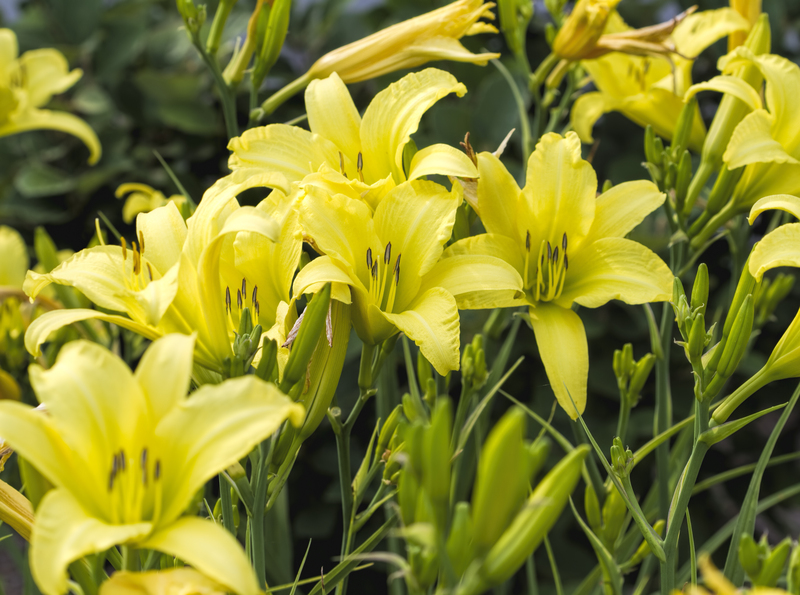The Gardener's Guide to Managing Windy Conditions
Posted on 18/06/2025
The Gardener's Guide to Managing Windy Conditions
Wind can be both a blessing and a challenge in the garden. While a gentle breeze stirs the air and helps prevent diseases, persistent or strong winds can damage plants, erode soil, and create stressful growing conditions. In this comprehensive guide, we'll explore practical, science-based strategies for managing windy conditions in your garden to ensure your green space thrives, no matter the weather.
Understanding the Impact of Wind in the Garden
Before diving into windy condition management, it's helpful to understand exactly how wind affects your garden ecosystem. Knowing this allows gardeners to develop tailored solutions for their landscapes.
How Wind Affects Plants
- Physical damage: Strong gusts can break stems, strip leaves, and even uproot young or shallow-rooted plants.
- Increased water loss: Wind leads to higher evapotranspiration, drying out soil and foliage much faster than calm or sheltered areas.
- Soil erosion: Exposed soil can be blown away, leading to nutrient loss and root exposure.
- Pest and disease movement: While airflow helps prevent fungal issues, wind can also carry spores and pests from other areas into your garden.
Which Plants Are Most Vulnerable?
- Tender annuals and young seedlings are particularly prone to breakage and drying out.
- Climbing plants and those with large leaves, such as sunflowers or squashes, catch more wind and are at higher risk of damage.
- Shallow-rooted species, which lack a strong anchor, are easily blown over.

Site Assessment: The First Step to Wind-Resistant Gardening
Every garden is unique. Start by identifying the specific challenges in your growing space:
- Observe where and when wind is most prevalent in your garden.
- Note the direction(s) of prevailing winds.
- Look for signs of existing wind damage - snapped stems, leaning trees, dry patches, or eroded soil.
Pro tip: Using simple tools like garden stakes with ribbons or wind vanes can help visualize airflow over a day or week, assisting in your planning.
Top Strategies for Managing Wind in the Garden
There is no one-size-fits-all solution for gardening in windy conditions. The best approach combines both physical barriers and smart planting choices. Here are essential methods to consider:
1. Installing Windbreaks and Shelters
Windbreaks are the most direct way to protect plants from harsh winds by reducing wind speed and creating a gentler microclimate.
- Living windbreaks: Hedges, rows of shrubs, or trees planted on the windward side of your garden can slow down and filter strong breezes. Good options include evergreens, bamboo, or dense native shrubs.
- Artificial barriers: Fences, woven willow screens, or even rows of stacked straw bales can block or deflect wind effectively.
- Temporary windbreaks: For seasonal crops or new plantings, use garden fabric, hessian, or plastic windbreak mesh attached to sturdy stakes.
Tips:
- The best windbreaks are porous, allowing some air to filter through rather than creating turbulence. Research shows a 40-60% density provides optimum protection.
- Windbreaks should be 5-8 times as long as their height to maximize the sheltered area.
- Allow windbreaks to extend just past the area you want to protect.
2. Using Microclimates to Your Advantage
Microclimates are small, local atmospheric zones where the climate differs from the surrounding area. Identify naturally sheltered spots - behind buildings, walls, or other landscape features - and locate fragile plants there.
- The south (or leeward) side of a fence or wall is often warmer, less windy, and ideal for less hardy species.
- Grow wind-sensitive herbs or veggies in the protection of courtyards, patios, or close to your home.
3. Staking and Supporting Vulnerable Plants
Don't underestimate the power of proper plant support in windy conditions. Young trees, tall flowers, and climbing crops all benefit from reinforcement:
- Use strong, flexible ties or soft garden tape to secure stems without causing damage.
- Install robust stakes, trellises, or cages for taller or climbing plants.
- Space supports to allow some movement. Total rigidity can make stems snap more easily than allowing gentle swaying.
4. Mulching and Soil Management
Wind can whip away precious topsoil and dry out garden beds. Mulching is an essential windproof gardening technique:
- Apply organic mulch, such as compost, bark chips, or straw, to exposed soil to reduce evaporation and prevent erosion.
- Plant low-growing ground covers or creeping plants to shield soil and hold it in place.
- For vegetable beds, try living mulches or interplant hardy fast-growing crops as wind buffers.
5. Smart Plant Selection and Placement
Selecting the right plants for breezy gardens is half the battle. Look for drought-tolerant, wind-resistant species for exposed sites:
- Native plants are often adapted to local windy conditions.
- Grasses and bamboo naturally sway and recover after gusts.
- Low-growing, flexible plants are less likely to be snapped or uprooted.
- Use windbreak plants in outer layers and shelter delicate varieties inside.
Arrange beds so the most wind-tolerant plants face the breeze, protecting more sensitive species behind them. Where possible, stagger plantings to diffuse airflow rather than creating hard straight barriers.
6. Watering Strategies for Windy Gardens
Windy sites dry quickly - your watering routine needs adjustment:
- Water early in the morning to minimize evaporation.
- Target the base of plants to reduce wet foliage and wind-driven water loss.
- Use drip irrigation or soaker hoses for deep and consistent moisture.
Advanced Methods for Wind Management
Creating Layered Windbreaks
Advanced wind-proof gardening relies on the "wind zone" concept. Instead of a single solid barrier, create a layered effect with:
- A row of tall trees or a solid fence as the first line of defense.
- A second line of medium-height shrubs behind.
- Low, dense planting inside the protected area for ground cover.
This technique slows wind gradually, minimizing swirling turbulence and protecting a larger area.
Raised Beds and Strategic Structures
Raised beds can reduce exposure for vegetables or tender flowers, especially when aligned perpendicular to prevailing winds. Similarly, strategic placement of greenhouses, sheds, or compost bins can create sheltered planting zones in your yard.
Common Mistakes in Windy Gardens (And How to Avoid Them)
Even the most experienced gardeners can make missteps in windy locations. Here are pitfalls to watch for:
- Building solid fences: Completely solid walls often cause dangerous turbulence rather than calm air. Always use slatted or mesh fencing.
- Poor watering practices: Underwatering is a major issue - be sure to check soil moisture regularly.
- Ignoring the direction of wind: Planting or sitting beds randomly can leave the most vulnerable plants exposed.
- Not maintaining windbreaks: Even the best hedge needs trimming, monitoring for gaps, and renewal planting over time.
Best Plants for Windy Gardens
Choosing wind-hardy varieties will make a huge difference in your success. Here are a few top recommendations for exposed locations:
Wind-Resistant Shrubs and Trees
- Tamarisk (Tamarix) - graceful, salt-tolerant, and ideal for coastal windbreaks.
- Pyracantha - densely branched and evergreen, great for living fences.
- Sea buckthorn (Hippophae rhamnoides) - tough, drought- and wind-resistant.
- Pittosporum - popular for hedge planting in exposed sites.
- Acer campestre (Field maple) and Hawthorn (Crataegus) - traditional windbreak trees.
Tough Perennials and Ground Covers
- Lavender - aromatic, drought-tolerant, and flexible in wind.
- Thyme and Oregano - good for low ground cover.
- Stipa and Festuca grasses - sway gracefully without breaking.
- Sedum and Eryngium - sturdy stems and wind-tolerant.
Edibles
- Chard, Kale, and Spinach - more tolerant than lettuces or soft-leafed greens.
- Carrots, onions, and beets - lower-growing root vegetables that resist wind.
- Peas and beans - climbing types need sturdy netting but do well with support.
Adapting Your Gardening Routine to Windy Weather
In addition to structural and planting changes, you can tweak your gardening practices to better suit windy environments:
- Start seedlings indoors or in sheltered spaces to give them a strong start before transplanting.
- Prune trees and shrubs regularly to reduce wind resistance and prevent limb breakage.
- Harvest leafy vegetables and flowers early on windy days, before winds increase later in the afternoon.
- Monitor for wind-borne pests like aphids or fungal diseases after storms. Clean up debris quickly.
Seasonal Wind Management Tips
Spring
- Secure new plantings and seedlings with temporary windbreaks or cloches.
- Watch for unseasonable gusts and cover tender plants as needed.
Summer
- Increase watering to compensate for higher evaporation rates.
- Use shading cloth alongside windbreaks for extra-sensitive crops.
Autumn
- Reinforce windbreaks and plant new hedges while soil is still warm.
- Rake and mulch fallen leaves to protect soil.
Winter
- Check and repair fences or structures after harsh storms.
- Add extra stakes or supports to young, top-heavy, or evergreen plants prone to snow and wind damage.

Innovative Ideas for Wind-Proof Gardening
Harness your creativity to turn wind challenges into unique features. Here are a few innovative ideas:
- Create natural wind art: Install mobiles, flags, or kinetic sculptures that dance in the breeze.
- Wind chimes and sound gardens: Make wind a sensory part of your garden's character.
- Wildlife habitats: Use thick, wind-tolerant plantings to provide shelter for birds and beneficial insects.
Conclusion: Thriving in the Face of Wind
Managing windy garden conditions may seem daunting, but with careful planning, the right windbreaks, supports, planting schemes, and watering strategies, your garden can flourish even in challenging sites. Use this gardener's guide to managing wind as a practical, adaptable framework to create a resilient, beautiful, and productive outdoor space. Let the wind be your garden's partner, not its enemy!
Remember: Every garden is different. Experiment with these tips and tailor your approach to your unique conditions for the best results. Happy gardening!

